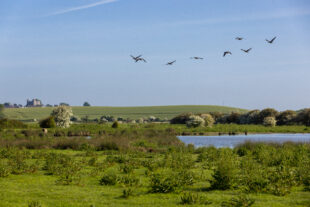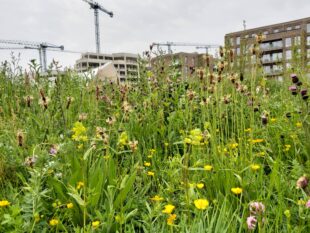
England doesn’t have enough houses, and also doesn’t have enough Nature. If we are to succeed in meeting our national needs, we require more of both. For too long we’ve been told that the only way to build more homes is to lose space for Nature while the only way to protect it is through a ‘ring of green steel’ around our towns and cities, known as the green belt.
But this isn’t working for people, Nature, or the environment.
Time for a nature positive planning
We need to look at the planning system differently. Currently planning applications are dealt with in a reactive site by site way, which is inefficient, resource intensive for all parties, and can cause delays to the development of housing and infrastructure. Building millions of homes while accelerating Nature recovery requires a joined-up approach that avoids environmentally harmful development while harnessing the contribution housing can make to restoring our natural world.
Stepping away from the current piecemeal approach and adopting a broader landscape view would enable the state of Nature, health of river catchments, water resources, climate change adaptation, levels of pollution and spaces for public enjoyment to be considered and planned in an integrated way, alongside the design of new residential areas. This would not only enable new homes to be built, but also create beautiful and healthy places.
Such an approach could be used across the country, including in what is presently greenbelt. For many the greenbelt has taken on totemic status and become sacrosanct, but parts of the greenbelt around England are pretty bereft of wildlife, have little value in terms of food production, and are closed off to the public. It seems to me though in many areas it could be made better than it is now - a greener and wilder belt.

Green infrastructure at the heart
Development could unlock the vital funding needed to turbo-charge recovery in these areas. New developments that are designed with good quality green infrastructure from the outset – for example with extensive mosaics of new wetlands, grasslands, native shrublands and woods, connected to new housing with footpaths and cycle ways – would create good places to live, from land that is at present not providing huge value to society. This, in turn, attracts skills and investments and improves the lives and wellbeing of the local community. This is supported by a growing wealth of evidence.
To do this, we need to go further with an ambitious and robust green infrastructure framework in local policy plans and design codes. This will ensure that development contributes positively toward Nature recovery, benefiting people, and contributing to the legal Environment Act targets. Ecologists, planners and developers working together can pull this off, so long as the direction of travel is clear and we move beyond the mindset of ‘the environment or houses’ and into one of ‘environment and houses’.
This has to be done correctly. It needs to involve everyone that has a stake and should not undermine areas where greenbelt is preventing urban sprawl.
It is right that the government should be focused on the so-called ‘grey belt’ - the lower quality land which has limited value for nature and wildlife. For example, a disused car park or petrol station that happens to be in the greenbelt. This should not be about reducing the protection of nature, rather it is about maintaining and going beyond those protections in ways that are quicker, more strategic, and more efficient.
Work is underway
There are growing examples where we are already delivering for nature while sustainable development goes ahead. In the Chilterns where demand for additional housing is putting pressure on the region’s protected sites and nationally important woodlands, we have created Sustainable Alternative Natural Greenspace for the community to use for recreation which has eased the pressure on the areas protected for wildlife and accommodated more homes for local people.

Another strategic solution we have in place is the nutrient mitigation scheme which has enabled more than 3,500 homes to be built in the Tees Valley. This pragmatic solution has stopped pollution from new homes entering our internationally important rivers and estuaries with the creation of new nature recovery sites which has enabled wildlife to thrive. We recently secured further nutrient mitigation at Lyscombe Farm in Dorset, where 3,700 homes can now be built within the Poole Harbour catchment while numerous rare birds, such as avocets, spoonbills and black-tailed godwits will be protected from additional pollution. Our position has not changed that new development should not worsen the condition of these sites and to maintain the environmental protection that underpins it. But there may be ways to deliver it that could be faster and more certain for developers and deliver even more for nature. We look forward to working on this with government so we can fulfil environmental and legal obligations while achieving the policy ambitions of Ministers.
Biodiversity Net Gain – a key part of the Environment Act – will also now ensure that new developments deliver at least a 10% gain for nature and leave the environment in a better state than it was found. Multiple developers have adopted this approach long before it became a mandatory requirement and gone far beyond the minimum 10% to deliver a legacy for nature and future generations. The Kidbrooke Village development in south east London has delivered over 100% Biodiversity Net Gain already, creating a real opportunity to halt and reverse species decline.
These solutions are pieces of the same puzzle which need to be used together in order to see the bigger picture and achieve the overarching aim of sustainable development which delivers for both people and nature.
It is time for the start of a national conversation about how to turbo-charge Nature recovery while building the homes the country needs. Our role at Natural England in this process is to advise the government on how to achieve its ambitious environmental targets through sustainable development. For example, we provided advice to the previous government on various options on how to achieve nutrient neutrality and received a direction to operate the Nutrient Mitigation Scheme.
We are one of the most Nature-depleted countries in the world and have a steep hill to climb to halt Nature decline by 2030 as the government has committed to doing. Making a change will not be easy, and these are difficult conversations – not least because we are an island which needs to balance different priorities competing for finite space, whether that’s land needed to produce food, energy or set aside for nature or housing.
Concerted action is needed from all parts of society to put Nature on the road to recovery, and a new approach toward how we plan new housing landscapes could be one powerful way for making progress.
This blog is a longer version of an opinion article first published on Sunday 28 July in the Sunday Telegraph.
6 comments
Comment by Mark David Walker posted on
One problem with the planning system is that we have a system which is market orientated! It entails too much personal risk to those making applications. It can easily cost over 1000 pounds to make an application. Then it can be rejected! This means planning is dominated by developers who can take the risk, but who thus go for what can make the most money- they want permission for large detached houses, which need the most land, but which can lead to the most profit. Bye Bye greebelt! Where I live there are many small bungalows, which people could convert into houses, increasing the housing stock without putting pressure on the green belt, but the risk of making an application to convert is too great a risk for such individuals. A system where local authorities could automatically grant planning permission, which would act to increase housing density, would encourage higher density development. If people were automatically given the choice to develop their bungalows into houses, or convert empty shops into flats, or develop that bit of brownfield, many would. But they won't risk making applications themselves because of the cost. I can't see what would be wrong with steering development more by giving permission for some developments, then letting people decide whether they want to utilise it or not.
Comment by rob yorke posted on
"We are one of the most Nature-depleted* countries in the world and have a steep hill to climb to halt Nature decline by 2030 as the government has committed to doing"
There is a danger of laudable though unachievable ambitious targets being weaponised rather than enabling smarter stacking of various public and private nature-recovery incentives.
Yes, a national conversation but set out the stalls as to which nature (skylarks or woodlarks, dung beetles or wood ants, waxcaps or birch bolete?) plus include trade-offs as part of the initial "framing" to help understand what the conservation entails.
*this phrase arrived via media headlining from a Biodiversity Intactness Index paper [https://www.nature.com/articles/nature03289] which was included in the eNGOs-led State of Nature report 2016. Its overuse can lose a room of nature-recovering land managers too easily!
best wishes, Rob
Comment by Ben Reed posted on
It should have been simple but International Obligations have not been met and known for years. Implementation, monitoring and actually delivery of promises but give communities help to do this, to fund community farms and help communities buy nature recovery as well. Not all about big corporations but help community led initiatives.
1. Deliver 30 by 30 choice to each town and in each parish ward. That is quick and delivers protected corridors.
2. CBD Deliver the Globally Biodiversity Targets and operationalise them in the NPPF
3. Give ancient and long established woodlands more protection greater than 100m buffers
4. Give 100m buffers minimum on Local Wildlife Sites and Local Geological sites invisible on planning maps
5. Protect and implement your Natural England All Habitats Combined methodology in the NPPF and mapped in MAGIC
6. Protected groundwater and headwater catchments and Biodiversity Opportunity Frameworks.
7. Implementation and Monitoring of the Habitats Regulation Assessments by OEP
8. Implementation and Monitoring of every applicable UN Sustainable Development Goals UN SDG
9. Nature is depleted because of habitat loss and other factors fragmentation and loss of insects. All new plans should have Invertebrate Assessments and protect HPI Habitats of Principal Importance and SPI Species of Principal Importance in planning policy. It has scant regard and carved up. BNG appears to not include Ancient Woodland harm and separates it , and should be included in BNG . Harm to AW and endangered species should be NO
10. Come and see how different it is for District Councillors powerless trying to protect corridors from ancient woodlands.
11. Establish the International Obligations signed up to
12. help us at the coal face witnessing the degradation and sites of high nature conservation value having no investment yet used by new developers estates.
Hope this helps as we are desperately trying to restore biodiversity
Comment by steve John maros posted on
The current drainage / sewage systems are not coping with the existing housing. More sewage is being released into waterways than ever before and clearly no steps are being taken to address this issue. Building substantially more new houses on greenfield sites, without sorting out the infrastructure, will just lead to more effluents and pollution going into our streams, rivers and the sea. This is not going to help Nature.
Regards
Steve Maros
Comment by P Kingsland posted on
Please help me understand why planning regulations are so relaxed around mobile home sites, who can install numerous luxury permanent homes adjacent to a SSSI (giving the land owner a healthy profit and income) whilst my application for an infill affordable home on an ex council estate is refused outright.
Scandalous double standards by Natural England and planning regulators, and no doubt just one example.
Surely, infill houses are a perfect way to supply truly affordable housing, with zero cost and inconvenience to government and council with an infrastructure already in place. The situation in 2024 a more realistic approach is needed to help address the crises we are in.
The argument of stopping additional footfall on the SSSI is utter nonsense as a self contained "granny" annexe & full size homes/extensions are granted permission as long as they remain integral to the original property . As are care homes, thier staff and visitors walking on the heath once they have driven to the area.
Come on NA, start thinking out the box!
Comment by Gaynor Aaltonen posted on
Let's not forget the other dimension. The new residents of these developments desperately want and need access to ‘nature’. They need relaxing open spaces near to where they live. Humans evolved in natural environments over millennia and our bodies are hard-wired to live in them. Today some 90% of people’s time is spent indoors, in homes, schools, at work - and in GP Practices. This is affecting population health on many levels – even eye health for children. It is almost literally killing some people (mainly through physical inactivity and induced inflammation). We must acknowledge that 'lifestyle' issues such as diabetes are linked to overwork, stress, and mental ill-health, caused in huge part by living in un-natural urban settings with a poverty of beauty, including levels of nature. Natural light deprivation isn't just about Vitamin D. NB I agree hugely with the spirit of what Tony Juniper is saying.